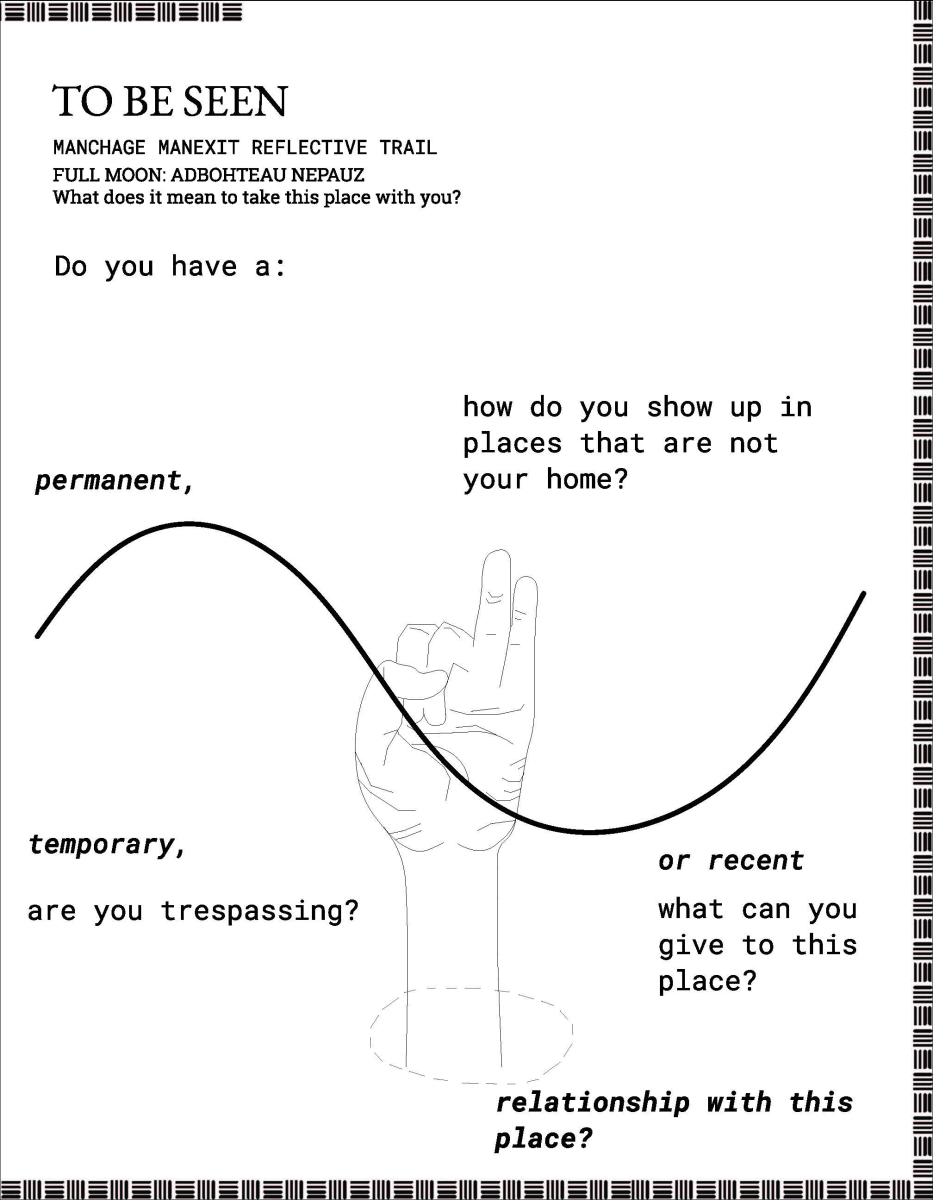You are here
Manchage Manexit: What does it mean to take this place with you?
The signs in this final section -- "What does it mean to take this place with you?" -- facilitate a better understanding of how being a visitor versus being "home" informs our relationship with the land. They follow the three levels of understanding and introspection introduced in earlier panels1.
Click the images on this page for a larger version of each sign.
Shown below, the I am budding sign in this series includes the following text:
TO BE SEEN
Manchage Manexit Reflective Trail
sugaring moon [text forms semicircle around winding lines that depict waterways]
What does it mean to notice
this place and where you
are within it?
Does this land know you?
Do YOU know the land?
TONNOH
KITTINNEMONCHEM?
Are you a visitor
or are you home?
What does it mean to
be home?
What does it mean to
be nourished by
these trees, by this
land?
--
Located in large text at the center of the sign, the Nipmuc phrase, "TONNOH KITTINNEMONCHEM?" draws attention while simultaneously leading the viewer to wonder how this phrase relates to the other questions posed on the sign. The final word on the sign, "land?" is formatted with large spaces between each letter, facilitating deeper thought about the question.
 Shown to the left, the I am sprouting sign in this series includes the following text:
Shown to the left, the I am sprouting sign in this series includes the following text:
TO BE SEEN
Manchage Manexit Reflective Trail
Full moon: Adbohteau nepauz
What does it mean to take this place with you?
Do you have a:
permanent,
temporary,
or recent
relationship with this place?
how do you show up in
places that are not
your home?
are you trespassing?
what can you
give to this
place?
--
The unique juxtaposition and formatting of the text on this sign requires the viewer to consider the order in which they could be read; above, the text is written where formatting is shared, as shown. Instead following a "Z" pattern, the viewer might instead read the same text in this order:
Do you have a:
permanent,
how do you show up in
places that are not
your home?
temporary,
are you trespassing?
or recent
what can you
give to this
place?
relationship with this
place?
 Shown to the left, the I am growing sign in this series includes the following text:
Shown to the left, the I am growing sign in this series includes the following text:
TO BE SEEN
Manchage Manexit Reflective Trail
Waning moon: Kuttaumen nepauz
What does it mean to take this place with you?
What does it mean
to be erased?
How do we reconcile the present
with this past and the future?
What do WE want to give
to future generations?
What does it mean to
live in HARMONY with a
place?
AQUENE KAH NAHONNUSHAGK
(peace and farewell)
--
The formatting of text on this sign is relatively straightforward, with two phrases larger than the others ("How do we reconcile the present with this past and the future?" and "AQUENE KAH NAHONNUSHAGK [peace and farewell].") At the top of the page, the phrase "What does it mean to be erased?" is located in a position that, without careful inspection, might be easily overlooked.
-------------
1The signs follow the three levels of understanding and introspection as introduced in earlier panels. "Ribbon I - I am budding" is symbolized by a hand closed with the pinky finger outstretched; "Ribbon II - I am sprouting" shows a hand with the two smallest fingers outstretched and the thumb closed over the pointer and index fingers; "Ribbon III - I am growing" shows a hand with all fingers closed except the index finger, which points assertively upward.
Back to the full trail description
- Introductory panels
- Panels 1-3: "What does it mean to walk the trail?"
- Panels 4-6: "What does it mean to be here?"
- Panels 7-9: "What does it mean to take this place with you?"


